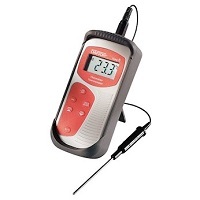
What is a thermistor?
Like the RTD, the thermistor is a temperature-sensitive resistor, and its operating principles are similar to those of the RTD. The difference with RTD is in the type of resistance used. Thermistors are usually made of semiconductors. In other words, thermistors are resistors with negative heat coefficient or NTC, which are made of semiconductor materials.
Thermistors are temperature sensors with a negative slope that their resistance decreases with increasing temperature. These sensors are characterized by non-linear metal alignment. One of the applications of thermistors is controlling the current passing through the motor windings. These sensors are very sensitive to temperature changes at low temperatures, but as the temperature increases, the sensitivity of these sensors decreases. Thermistors can be used to measure low temperatures.
The temperature coefficient of a resistor is the percentage of resistance changes per degree of temperature change.
One degree change in temperature ÷% change in resistance = temperature coefficient of a resistor
Most thermistors have a negative temperature coefficient, although they may also have a positive temperature coefficient. A negative temperature coefficient means that the resistance of the thermistor decreases with increasing temperature. The temperature coefficient can be several percent, which allows the detector circuit to detect minor changes in temperature. It can be said that the thermistor is the most sensitive sensor. The change in resistance of the thermistor is measured by the Weststone Bridge circuit.
The difference between a thermistor and an RTD
Thermistors have a high resistance to RTDs. A typical value for the resistance of thermistors is 5000 ohms at 25 ° C. While this value is 100 ohms for RTD. As a result, the resistance of the connecting wires is very small compared to the resistance of the thermistors, and therefore the connecting wires do not cause a measurement error and there is no need for three-wire or four-wire arrangements to measure. Thermistors can be made in very small sizes so they have a faster response than RTDs.
Features of thermistors
Thermistors have completely nonlinear outputs and are less accurate than RTDs. Also, thermistors are more fragile than RTD and thermocouples and care must be taken in their installation. Because thermistors are semiconductors, they break down faster at shorter temperatures than RTDs and thermocouples and have a shorter life.
The phenomenon of autotherm in thermistors is more acute than RTDs because the electrical resistance of thermistors is much higher than RTDs and therefore the passage of a certain current produces more heat in them.
But thermistors have a short response time. In addition, low price and small size are other features of thermistors. But the installation of temperature changes shows large changes in resistance. They are also nonlinear and require a current source for their operation. Another disadvantage of thermistors is their low temperature range. On the other hand, they are not easily adjustable.
Another problem with thermistors is their high tolerance, so that thermistors made by a company and under the same name and number are not exactly the same in terms of behavior and characteristics, causing problems when replacing and moving measuring elements.
Rose Calibration Company in Melbourne, Australia with over ten years of experience provides all calibration, maintenance, and repair services throughout Australia. If you live in Sydney, Melbourne, Adelaide, Perth, Geelong, and Brisbane, you can receive your quote in less than two hours by fill-up the form via the “Booking” link.

